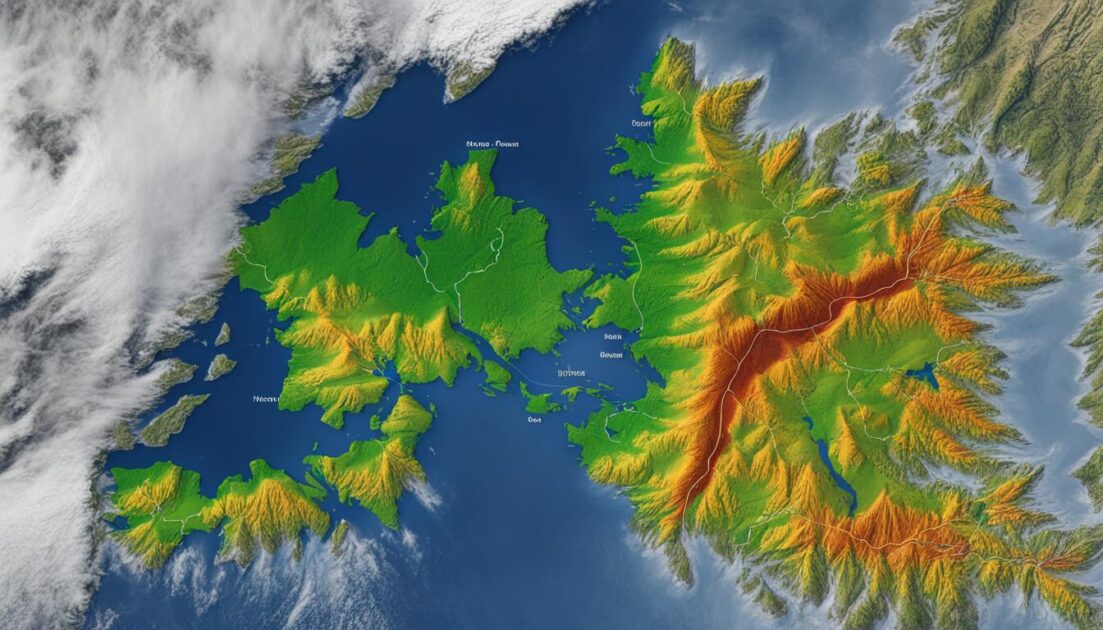Mount Rainier National Park is a stunning destination known for its beautiful landscapes, including meadows of wildflowers, old-growth forests, waterfalls, and breathtaking mountain views. In this article, I will provide a comprehensive guide to planning a trip to Mount Rainier, including information on weather conditions, key attractions, activities, and more.
Key Takeaways:
- Mount Rainier Weather plays a crucial role in trip planning.
- Check the Mount Rainier forecast for temperature, snow conditions, and hiking/climbing weather.
- Research key attractions like Paradise, Sunrise, Longmire, and more.
- Engage in various activities such as hiking, camping, wildlife watching, and ranger-led programs.
- The best time to visit Mount Rainier is during the summer and early fall months.
Weather at Mount Rainier National Park
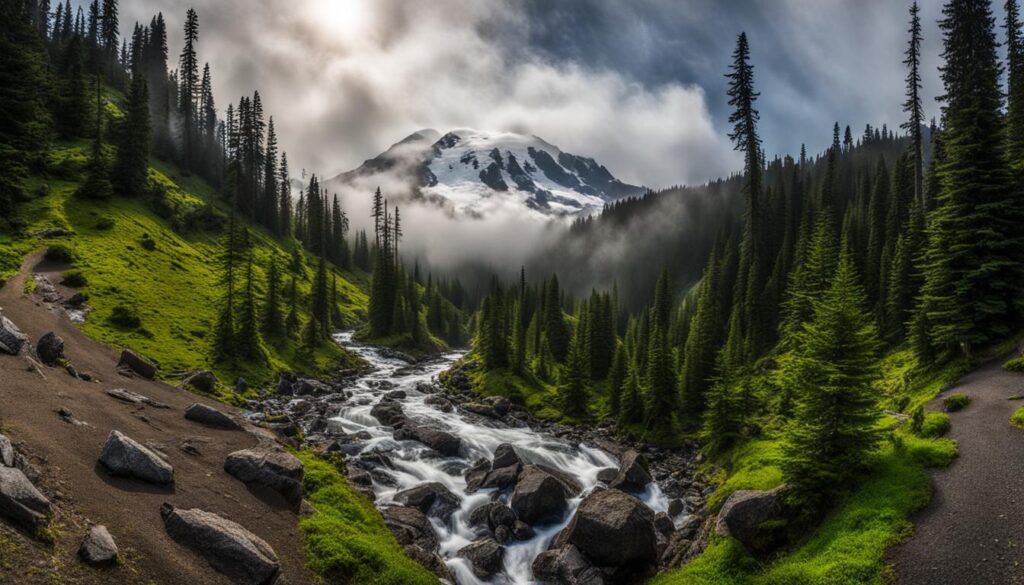
The weather at Mount Rainier is influenced by its proximity to the Pacific Ocean, elevation, and latitude. The climate is generally cool and rainy, with summer highs in the 60s and 70s. July and August are the sunniest months, but rain is possible throughout the year. Snow can be present at higher elevations well into mid-July. Visitors should be prepared for changing weather conditions and check forecasts before their trip.
To help you plan your visit, here is a breakdown of the average temperatures and precipitation at Mount Rainier National Park:
| Month | Average High (°F) | Average Low (°F) | Precipitation (inches) |
|---|---|---|---|
| January | 35 | 22 | 11.2 |
| February | 38 | 24 | 8.8 |
| March | 42 | 27 | 10.3 |
| April | 50 | 31 | 6.7 |
| May | 58 | 38 | 4.7 |
| June | 65 | 44 | 3.8 |
| July | 71 | 49 | 1.3 |
| August | 70 | 48 | 1.5 |
| September | 64 | 41 | 3.5 |
| October | 53 | 35 | 8.1 |
| November | 41 | 28 | 12.3 |
| December | 36 | 24 | 11.4 |
Note: These are average values and the actual weather conditions may vary.
As you can see from the table, the weather at Mount Rainier can vary significantly throughout the year. It’s important to pack appropriate clothing and gear to ensure your comfort and safety during your visit. Layers are recommended, as temperatures can change rapidly, especially at higher elevations. Additionally, it’s advisable to carry rain gear and be prepared for wet conditions, as rain is common in the park.
Before heading to Mount Rainier, make sure to check the weather forecast and any advisories or alerts issued by the park. The National Park Service provides up-to-date information on weather conditions and road closures, which can be invaluable for planning your trip and ensuring a smooth and enjoyable experience at Mount Rainier National Park.
Key Attractions at Mount Rainier National Park
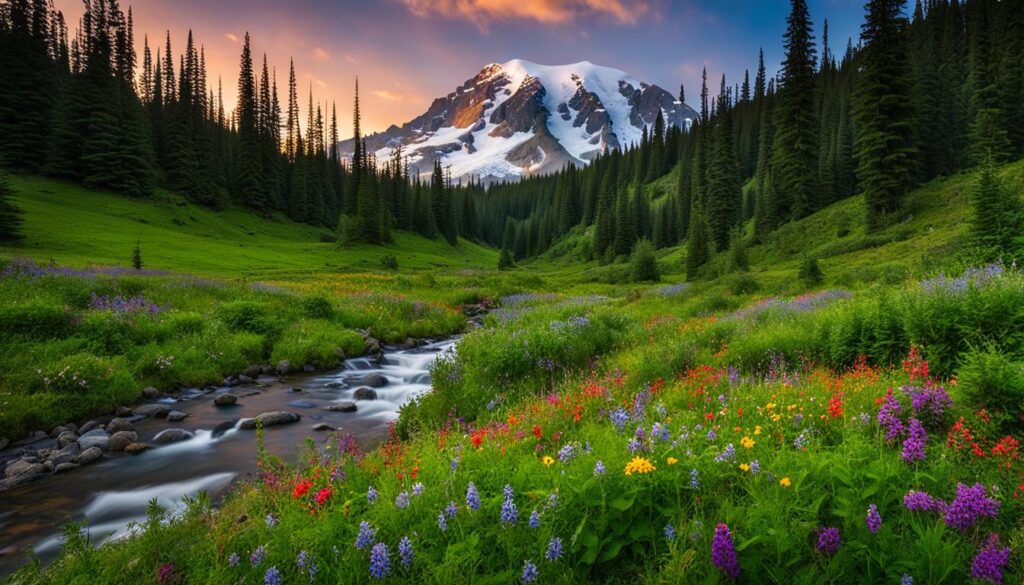
Mount Rainier National Park offers a plethora of breathtaking attractions for visitors to explore. From stunning landscapes to historical sites, there is something for everyone to enjoy. Here are some of the key attractions to add to your itinerary:
Paradise
Nestled on the southern side of Mount Rainier, Paradise is a must-visit destination for nature lovers. Known for its picturesque wildflower meadows, this area offers numerous hiking trails with stunning views of the mountain. Don’t miss the iconic Paradise Inn, a historic lodge that has been welcoming guests since 1916.
Sunrise
For awe-inspiring views of Mount Rainier and the surrounding landscapes, head to Sunrise. Located on the northeastern side of the park, this area offers access to incredible wildflower meadows and panoramic vistas. It’s a hiker’s paradise with trails ranging from easy strolls to more challenging adventures.
Longmire
Step back in time at Longmire, the historic district of Mount Rainier National Park. Explore the charming National Park Inn, which dates back to 1916, and soak in the rich history of the area. You can also embark on scenic hikes and discover the beauty of the old-growth forests that surround Longmire.
Ohanapecosh
If you’re looking to immerse yourself in nature, Ohanapecosh is the place to be. This area is home to ancient forests filled with towering trees, crystal-clear rivers, and serene waterfalls. Visit the Ohanapecosh Visitor Center to learn more about the park’s unique ecosystems.
Carbon River, Mowich Lake, Nisqually Entrance, White River Entrance, Stevens Canyon Entrance
Mount Rainier National Park also offers various entrances and areas to explore. The Carbon River area is known for its beautiful trails and camping opportunities. Mowich Lake captivates visitors with its tranquil beauty and scenic hiking trails. The Nisqually Entrance, White River Entrance, and Stevens Canyon Entrance provide access to different parts of the park, each offering its own unique experiences.
With so many attractions to discover, Mount Rainier National Park is a true gem of the Pacific Northwest. Whether you’re an avid hiker, a nature enthusiast, or a history buff, this park has something to offer. Prepare to be amazed by the beauty of the landscapes, the rich biodiversity, and the captivating history that awaits you at Mount Rainier National Park.
Activities and Things to Do at Mount Rainier National Park
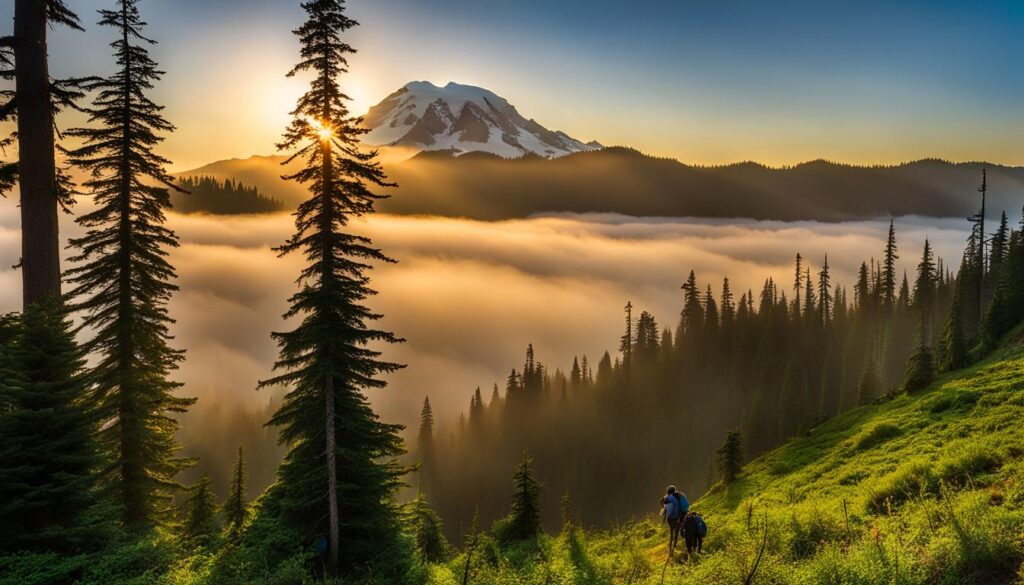
When visiting Mount Rainier National Park, there is no shortage of activities to keep you engaged and immersed in the park’s natural wonders. Whether you’re an avid hiker, a wildlife enthusiast, or simply enjoy soaking in breathtaking views, Mount Rainier offers something for everyone.
Hiking
Hiking is one of the most popular activities in Mount Rainier National Park, and for good reason. With over 260 miles of trails, ranging from easy strolls to challenging treks, there’s a hike suitable for every level of experience. Lace up your boots and explore the picturesque meadows, cascading waterfalls, and ancient forests that make up the park’s diverse landscapes. Don’t forget to check trail conditions and any necessary permits before setting out on your adventure.
Camping
Experience the magic of Mount Rainier by spending a night under the stars in one of the park’s campgrounds. Wake up to the sounds of nature and enjoy the tranquility of your surroundings. From developed campsites with amenities to more primitive options, there are choices to suit every camping preference. Keep in mind that some campsites require reservations, so plan ahead to secure your spot.
Wildlife Watching and Wildflower Viewing
Mount Rainier National Park is home to a variety of wildlife, including deer, elk, black bears, and even the occasional mountain goat. Grab your binoculars and keep your eyes peeled as you explore the park, as you never know what magnificent creature you might encounter. In addition to wildlife, the park boasts vibrant wildflower displays during the summer months. Be sure to visit the renowned meadows of Paradise and Sunrise to witness nature’s colorful spectacle.
Ranger-led Programs
Delve deeper into the wonders of Mount Rainier with ranger-led programs. Join a guided hike, attend an informative talk or get hands-on with interactive demonstrations. These programs offer valuable insights into the park’s history, geology, and ecology, providing a deeper appreciation for the natural treasures that surround you.
Winter Recreation
Embrace the winter wonderland that Mount Rainier becomes during the colder months. Engage in snowshoeing, sledding, or cross-country skiing, and experience the park in a whole new light. Enjoy the peaceful serenity of snow-covered trails and be rewarded with stunning views and a sense of adventure that only winter can bring.
With its abundance of activities, Mount Rainier National Park promises an unforgettable experience for nature enthusiasts and adventurers alike. So, lace up your hiking boots, pack your camping gear, and get ready to immerse yourself in the natural wonders of this breathtaking national park.
Best Times to Visit Mount Rainier National Park
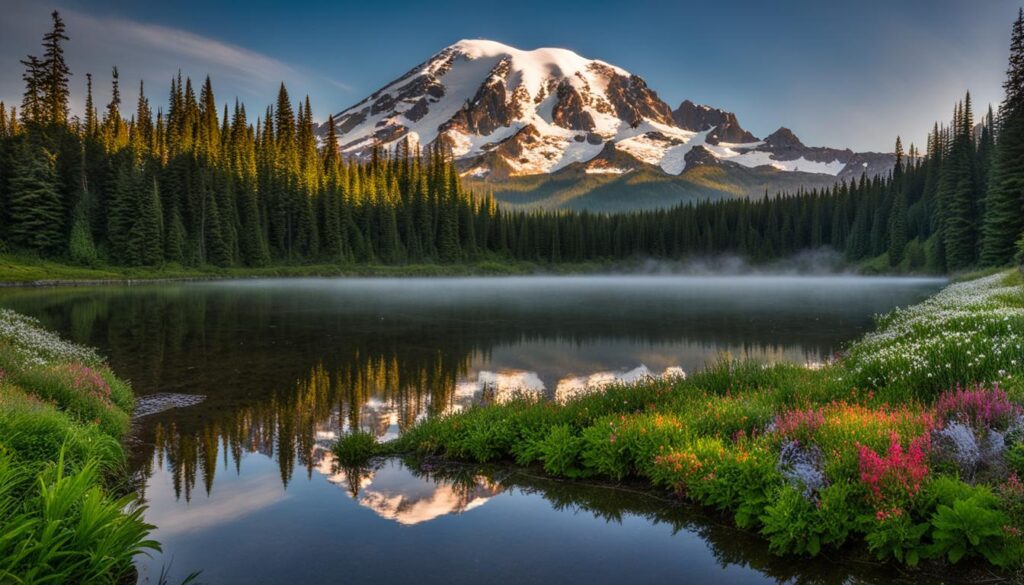
The timing of your visit to Mount Rainier National Park can greatly impact your experience. Here, I will outline the best times to visit the park based on the seasons and highlight the unique attractions each season offers.
Summer (June to August)
Summer is the peak season at Mount Rainier National Park, and for good reason. The weather is generally pleasant, with average temperatures ranging from the 60s to 70s Fahrenheit. This is the best time to explore the park’s numerous hiking trails, enjoy wildflower blooms, and witness stunning views of the mountain. The Paradise area, in particular, is known for its vibrant meadows filled with colorful flowers.
Fall (September to November)
Fall brings cooler temperatures and changing colors to Mount Rainier National Park. The park’s forests transform into a vibrant tapestry of reds, oranges, and yellows, creating a picturesque landscape. Fall is also a quieter time to visit, with fewer crowds compared to the summer months. It’s a great time for hiking, wildlife spotting, and capturing breathtaking photos of the fall foliage.
Winter (December to February)
Winter at Mount Rainier National Park offers a completely different experience. The park transforms into a winter wonderland, with snow-covered landscapes and a peaceful atmosphere. Winter sports enthusiasts can enjoy activities such as snowshoeing, cross-country skiing, and sledding. The park’s annual Winter Wonderland event, held in December, features a festive atmosphere with activities for the whole family.
Spring (March to May)
As the snow begins to melt and temperatures rise, spring brings new life to Mount Rainier National Park. This is the time when waterfalls are at their peak, and the park’s rivers and streams are filled with cascading water. Spring also marks the return of wildlife to the park, making it a great time for birdwatching and spotting other animals. Hiking trails start to open up, offering opportunities to explore the rejuvenated landscapes.
Each season at Mount Rainier National Park has its own unique charm and attractions. Whether you prefer the vibrant wildflowers of summer, the stunning fall foliage, the snowy landscapes of winter, or the awakening of nature in spring, there’s always something special to experience at this majestic national park.
Hours and Operations at Mount Rainier National Park
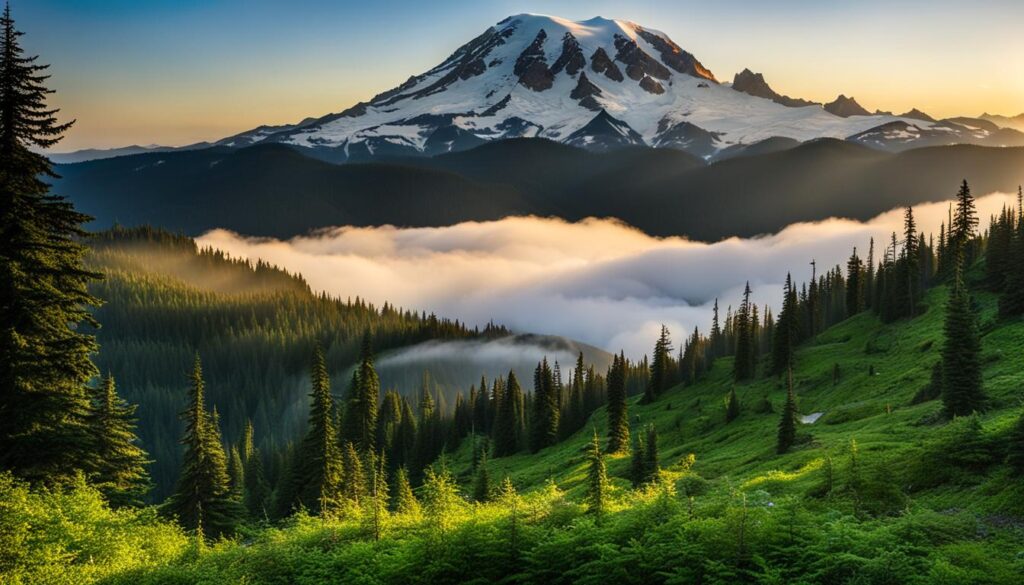
Planning a visit to Mount Rainier National Park involves considering the park’s hours of operation, available visitor centers, entrance fees, and pass options. It’s important to have this information in advance to ensure a smooth and enjoyable experience at the park.
Visitor Centers
Mount Rainier National Park has several visitor centers located throughout the park, offering valuable information, exhibits, and assistance to visitors. These centers provide detailed maps, guidebooks, and knowledgeable staff who can help plan your visit and answer any questions you may have. Some of the main visitor centers within the park include:
- Paradise Jackson Visitor Center
- Ohanapecosh Visitor Center
- Longmire Museum
These visitor centers operate during specific hours and seasons, so it’s important to check the official park website for the most up-to-date information.
Park Hours
Mount Rainier National Park is open 24 hours a day, 365 days a year. However, some areas within the park may have seasonal closures or limited access during winter months due to weather conditions. It’s important to note that while the park is open year-round, access to certain trails, roads, and facilities may vary depending on the time of year.
Entrance Fees and Passes
Visitors to Mount Rainier National Park are required to pay an entrance fee, which helps support the park’s maintenance and preservation efforts. The current entrance fees are as follows:
| Vehicle | Individual | Motorcycle |
|---|---|---|
| $30 | $15 | $25 |
These fees are valid for a 7-day entrance permit. Alternatively, visitors can purchase an annual pass for $55, which grants unlimited entry to Mount Rainier National Park for one year. Additional pass options, such as the America the Beautiful Interagency Pass, are also accepted.
Before planning your visit, be sure to check the park’s official website for any updates, changes to fees, and current hours of operation. By being well-informed and prepared, you can make the most of your trip to Mount Rainier National Park.
RV Parks and Camping at Mount Rainier National Park

When visiting Mount Rainier National Park, camping is a popular option for immersing yourself in the beauty of the park’s natural surroundings. There are several campgrounds available, providing visitors with the opportunity to connect with nature and enjoy the serene atmosphere. Whether you prefer pitching a tent or parking your RV, Mount Rainier offers options for all campers.
Campgrounds
Mount Rainier National Park features three main campgrounds: Cougar Rock, Ohanapecosh, and White River. Each campground offers different amenities and unique experiences for campers. Here is a brief overview of each campground:
| Campground | Description |
|---|---|
| Cougar Rock | A popular campground located in the southwest corner of the park. It offers easy access to hiking trails and stunning views of Mount Rainier. Amenities include picnic tables, drinking water, and restrooms. |
| Ohanapecosh | Situated in the southeast corner of the park, Ohanapecosh campground is surrounded by ancient forests and crystal-clear rivers. It provides campers with picnic areas, drinking water, restrooms, and a nearby visitor center. |
| White River | Located on the northeast side of the park, White River campground offers breathtaking views of glaciers and rugged mountain landscapes. It is a popular choice for those looking to explore the park’s eastern wilderness. Amenities include picnic tables, drinking water, and restrooms. |
Please note that these campgrounds may have limited availability, especially during peak seasons. It is recommended to make reservations in advance to secure a spot. Additionally, be sure to check the park’s official website for current campground conditions, rules, and regulations.
Hotels, Campsites, and Cabins at Mount Rainier National Park
When planning a trip to Mount Rainier National Park, it’s important to consider your lodging options. Whether you prefer the comfort of a hotel, the simplicity of a campsite, or the coziness of a cabin, there are accommodations available to suit your needs.
Hotels
If you’re looking for a comfortable and convenient option, there are hotels located both within and near Mount Rainier National Park. The National Park Inn, located in the historic district of Longmire, offers rustic accommodations and a peaceful atmosphere. The inn provides easy access to hiking trails and scenic views. The Paradise Inn, located in the Paradise area of the park, offers a charming and historic hotel experience with breathtaking mountain views.
Campsites
For those who want to immerse themselves in nature, camping is a popular choice at Mount Rainier National Park. There are several campgrounds within the park, including Cougar Rock, Ohanapecosh, and White River. These campgrounds offer a range of amenities, such as picnic tables, fire pits, and restroom facilities. It’s important to note that some campgrounds require reservations, so be sure to plan ahead.
Cabins
If you’re seeking a more secluded and private experience, cabins are available near Mount Rainier National Park. These cabins provide a cozy and comfortable retreat for visitors looking to relax and enjoy the natural surroundings. Cabins offer amenities such as kitchens, fireplaces, and scenic views. Ashford and Packwood are two nearby towns that offer cabin rentals.
| Type of Accommodation | Description | Location | Website |
|---|---|---|---|
| Hotels | National Park Inn | Longmire | www.examplehotel.com |
| Paradise Inn | Paradise | www.examplehotel.com | |
| Campsites | Cougar Rock Campground | Mount Rainier National Park | www.examplecampground.com |
| Ohanapecosh Campground | Mount Rainier National Park | www.examplecampground.com | |
| White River Campground | Mount Rainier National Park | www.examplecampground.com | |
| Cabins | Ashford Cabins | Ashford | www.examplecabins.com |
| Packwood Cabins | Packwood | www.examplecabins.com |
Whether you choose to stay in a hotel, campsite, or cabin, booking your accommodations in advance is recommended, especially during peak seasons. By selecting the lodging option that best suits your preferences, you can fully enjoy your visit to Mount Rainier National Park and create lasting memories.
Planning Your Visit to Mount Rainier National Park
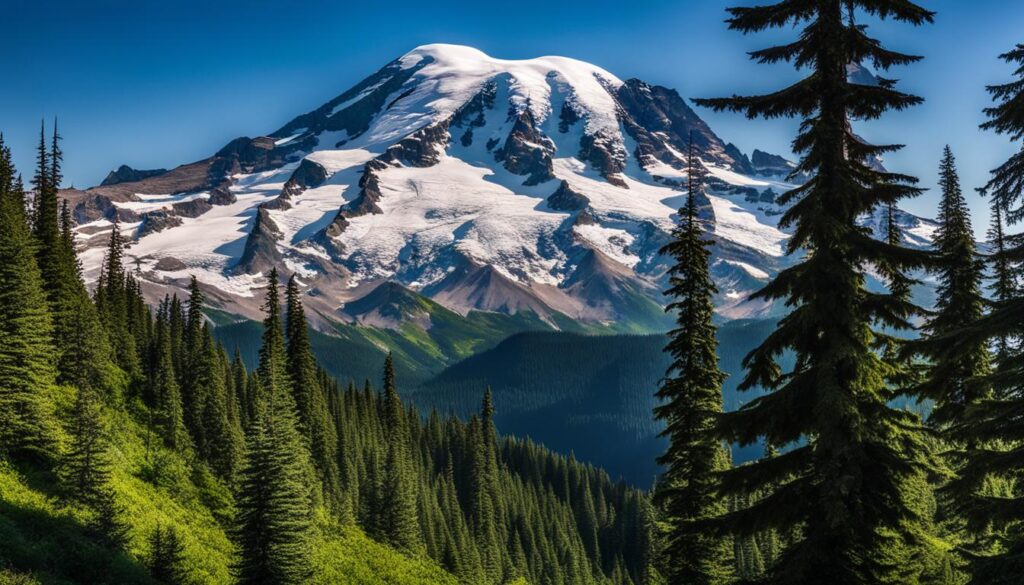
When planning your visit to Mount Rainier National Park, there are several key factors to consider. From directions and maps to visitor information, careful planning can help ensure a smooth and enjoyable trip to this beautiful destination.
Directions: Getting to Mount Rainier National Park is relatively straightforward, but it’s important to plan your route in advance. The park is located in Washington state, approximately 2 hours from Seattle. From Seattle, take I-5 south to WA-7 south, which will lead you directly to the park’s Nisqually Entrance. There are also other park entrances accessible via different routes, so be sure to choose the one that suits your needs best.
Maps: Before embarking on your journey, it’s recommended to obtain a map of Mount Rainier National Park. Maps are available at the park’s visitor centers or can be downloaded online from the park’s official website. These maps provide valuable information on park roads, trails, and key attractions, helping you navigate the park effectively.
Visitor Information: Familiarize yourself with important visitor information before your trip. The park’s official website is a valuable resource for up-to-date information on park hours, fees, passes, rules, and regulations. Additionally, consider checking weather forecasts, trail conditions, and any alerts or advisories that may affect your visit.
| Visitor Resources | Contact Information |
|---|---|
| Mount Rainier National Park Official Website | https://www.nps.gov/mora/index.htm |
| Main Visitor Center (Ashford, WA) | Phone: (360) 569-2211 |
| Longmire Museum and Wilderness Information Center | Phone: (360) 569-6575 |
By carefully planning your visit to Mount Rainier National Park, you can optimize your time and make the most of this extraordinary natural wonder. Remember to check for any updates or changes before your trip to ensure a seamless and unforgettable experience.
Testimonials
“Planning our visit to Mount Rainier was made easy with the helpful resources provided by the park. The maps and visitor information helped us navigate the park and choose the best trails for our hiking adventure.” – Sarah, California
“The directions to Mount Rainier were straightforward, and we didn’t encounter any issues finding our way to the park. Having the visitor information handy allowed us to plan our trip efficiently and make the most of our time exploring this stunning national park.” – John, Washington
Conclusion
As I conclude this Mount Rainier travel guide, I hope you have gained valuable information and insights to plan your visit to this awe-inspiring national park. Mount Rainier offers a unique and unforgettable experience with its stunning natural landscapes and diverse attractions.
Remember to follow these Mount Rainier tips for a successful trip. Firstly, check the Mount Rainier weather forecast and be prepared for changing conditions. Secondly, make sure to visit during the best time for optimal weather and trail conditions, avoiding peak crowds if possible. Thirdly, plan your itinerary and activities in advance, taking advantage of opportunities such as ranger-led programs and wildlife viewing.
For more Mount Rainier information, consult official park resources, including maps, visitor centers, and the park’s website. These sources will provide you with the most up-to-date details on park hours, entrance fees, and pass options. Lastly, be respectful of the park’s natural environment and wildlife by practicing Leave No Trace principles.
FAQ
What is the weather like at Mount Rainier National Park?
The weather at Mount Rainier is generally cool and rainy, with summer highs in the 60s and 70s. July and August are the sunniest months, but rain is possible throughout the year. Snow can be present at higher elevations well into mid-July. Visitors should be prepared for changing weather conditions and check forecasts before their trip.
What are the key attractions at Mount Rainier National Park?
Some of the main areas in the park include Paradise, Sunrise, Longmire, Ohanapecosh, Carbon River, and Mowich Lake. Each area offers unique landscapes and attractions, such as wildflower meadows, historic inns, old-growth forests, and beautiful trails. There are also various park entrances, including Nisqually, White River, and Stevens Canyon.
What activities can I enjoy at Mount Rainier National Park?
Popular activities at the park include hiking, camping, wildlife watching, and viewing wildflowers. There are a variety of trails for all skill levels, campgrounds for overnight stays, and opportunities to spot birds and other wildlife. The park also offers ranger-led programs for visitors interested in learning more about the park’s history, geology, and wildlife. In winter, there are options for snowshoeing and sledding.
When is the best time to visit Mount Rainier National Park?
The best time to visit is generally during the summer and early fall months, from July to October. This period offers the best weather, snow-free trails, and the chance to see wildflowers in bloom. However, it’s important to note that Mount Rainier can experience variable weather conditions throughout the year, so it’s recommended to research and plan accordingly.
What are the hours and operations at Mount Rainier National Park?
The hours and operations at the park can vary depending on the season and specific areas within the park. Visitor centers, entrance fees, and the availability of facilities may also vary. It’s important to check the park’s official website or contact the park for the most up-to-date information on hours, services, entrance fees, and pass options.
Are there camping options at Mount Rainier National Park?
Yes, Mount Rainier National Park offers several campgrounds for visitors, including Cougar Rock, Ohanapecosh, and White River campgrounds. These campgrounds may have limited facilities and availability, so it’s recommended to make reservations in advance. There are also options for RV parks and camping outside of the park, as well as cabins for those looking for more comfortable accommodations.
What lodging options are available at Mount Rainier National Park?
In addition to campgrounds, Mount Rainier National Park has lodging options such as the National Park Inn in Longmire and the Paradise Inn in Paradise. These historic inns offer accommodations within the park. There are also options for hotels, cabins, and campsites outside of the park in nearby towns like Ashford and Packwood.
How do I plan a visit to Mount Rainier National Park?
Planning a visit involves considering factors such as the best time to go, obtaining maps and visitor information, and determining the best route and directions to the park. It’s important to plan ahead and be prepared for variable weather conditions, limited facilities, and potential crowds, especially during peak seasons.

